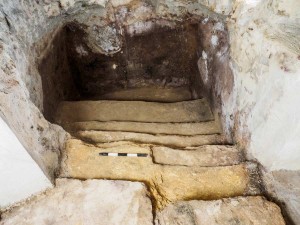Historians believe discovery could have important implications
Renovations often don’t go according to plan. But Tal and Oriah Shimshoni got more than they bargained for when they found a 2000-year-old mikve, or ritual bath, under their living room floor in the neighborhood of Ein Karem, better known as the home town of John the Baptist.
“Initially, we were uncertain about the importance of the find,” Oriah Shimshoni told reporters invited by the Israeli Antiquities Authorities (IAA) to see the perfectly preserved find. “We felt that this find deserves to be seen and properly documented. We contacted the IAA at our own initiative in order that they would complete the excavation and the task of documenting the discovery.”
The mikve, or ritual bath, was used by Jews for purification before they visited the Second Temple in Jerusalem, which was destroyed in 70 AD. Today, a mikve is used by Orthodox women after they finish their menstruation cycle before they can have sex with their husbands.
IAA archaeologists said the mikva is quite large, made of rock and plastered. A staircase leads to the bottom of the pool that is used for immersion. They also found pottery vessels dating from the time of the Second Temple and traces of fire that could go back to the destruction of the Second Temple.
“Such instances of finding antiquities beneath a private home can happen only in Israel and Jerusalem in particular,” Amit Re’em, Jerusalem District Archaeologist told reporters. “Ein Karem is considered a place sacred to Christianity in light of its identification with the “city of Judah” – the place where according to the New Testament, John the Baptist was born and where his pregnant mother Elisabeth met with Mary, mother of Jesus.”
It also has implications for Jewish history, he said.
“Despite these identifications, the archaeological remains in Ein Kerem and the surrounding area, which are related to the time when these events transpired (the Second Temple Period), are few and fragmented. The discovery of the ritual bath reinforces the hypothesis that there was a Jewish settlement from the time of the Second Temple located in the region of what is today Ein Karem.”
